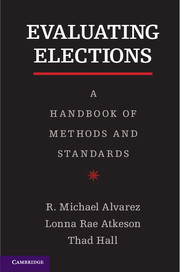Book contents
- Frontmatter
- Contents
- Acknowledgments
- Introduction
- 1 The Electoral Ecosystem
- 2 Easily Available Data for Performance Evaluation
- 3 Measuring the Experiences of Voters
- 4 Measuring the Performance of Poll Workers
- 5 Auditing the Election Ecosystem
- 6 Election Observation
- Conclusion
- Appendix: Precinct Opening, Closing, Election Day Forms
- References
- Index
1 - The Electoral Ecosystem
Published online by Cambridge University Press: 05 December 2012
- Frontmatter
- Contents
- Acknowledgments
- Introduction
- 1 The Electoral Ecosystem
- 2 Easily Available Data for Performance Evaluation
- 3 Measuring the Experiences of Voters
- 4 Measuring the Performance of Poll Workers
- 5 Auditing the Election Ecosystem
- 6 Election Observation
- Conclusion
- Appendix: Precinct Opening, Closing, Election Day Forms
- References
- Index
Summary
For most citizens, the exact operations of democratic government are a bit of a mystery. Ask even relatively well-informed citizens about how the U.S. Congress does its business, what precisely it is that a state lieutenant governor does on a daily basis, or when their local city council or school board meets, and you will likely get a shrug of the shoulders and “I’m not sure” in response. Countless surveys and studies have found that citizens can be very uninformed about how their government works (Delli Carpini and Keeter 1997).
This seems particularly true when it comes to one of the most important aspects of representative democracy: the administration of elections. Few voters are aware of what happens in the election prior to their receipt of a blank ballot – either a piece of paper or a direct recording electronic (DRE) voting machine screen – on which they are asked to vote. Few understand the logistics of sending out paper ballots as part of running an absentee balloting process, which is one of the fastest-growing methods of voting in the United States. They do not appreciate the complexity of the logistics of running early voting (another very quickly growing election process) or running Election Day precincts. Few voters – and not so many advocates and politicians! – have much of a clue about what happens to their ballot after they complete it and drop it in the ballot box, press “cast ballot” on the DRE, or drop their postal vote in a mailbox. A relatively small group of academics, advocates, candidates for public office (and the advisors who help them in that effort), and those who actually administer elections for their living appreciate the complexity of the process.
- Type
- Chapter
- Information
- Evaluating ElectionsA Handbook of Methods and Standards, pp. 19 - 38Publisher: Cambridge University PressPrint publication year: 2012



